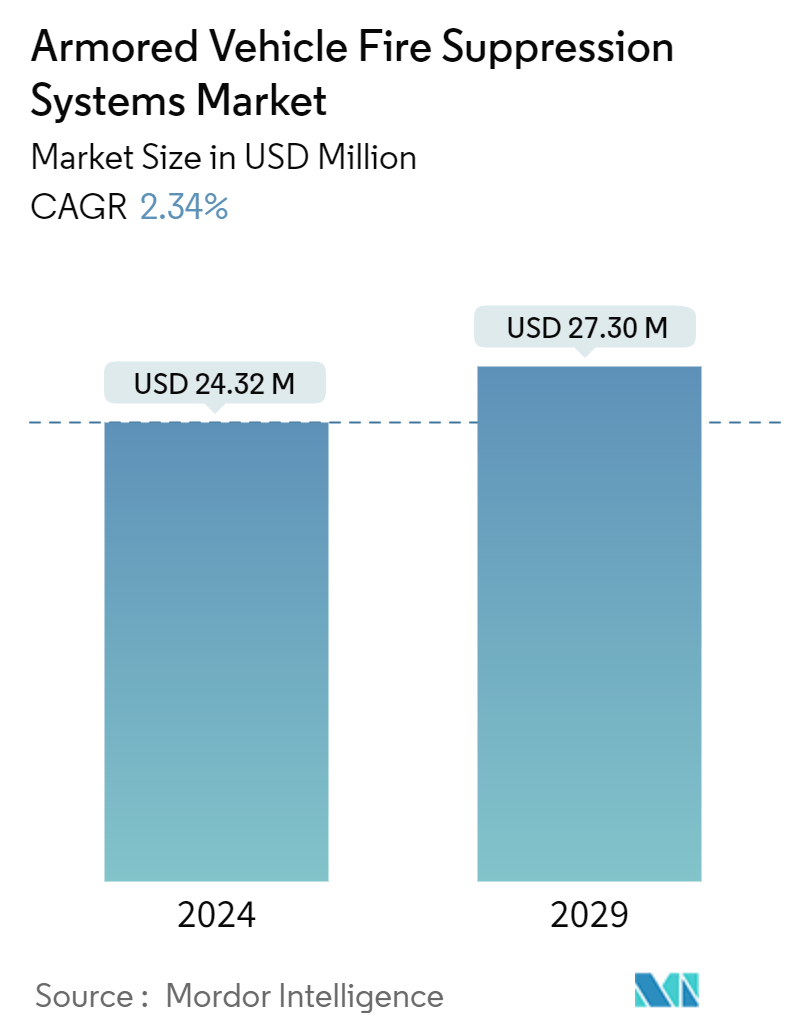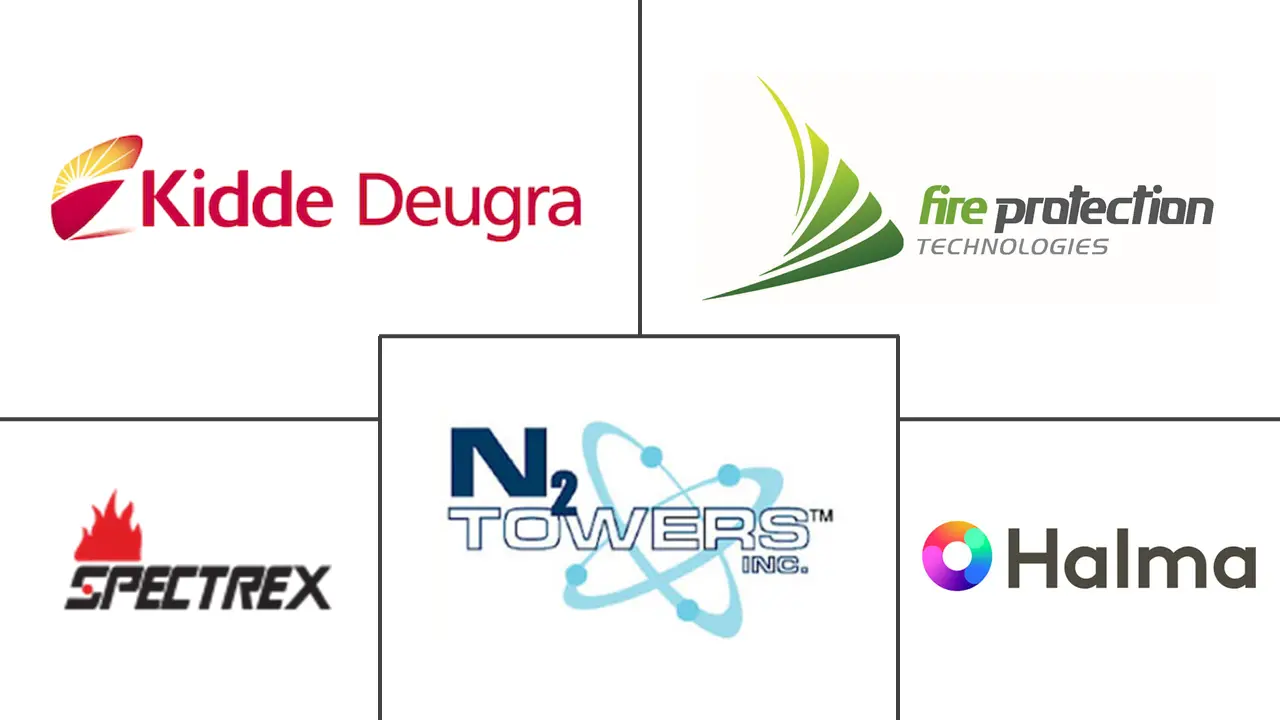Market Size of Armored Vehicle Fire Suppression Systems Industry

| Study Period | 2019 - 2029 |
| Market Size (2024) | USD 24.32 Million |
| Market Size (2029) | USD 27.30 Million |
| CAGR (2024 - 2029) | 2.34 % |
| Fastest Growing Market | Asia Pacific |
| Largest Market | North America |
| Market Concentration | Medium |
Major Players
*Disclaimer: Major Players sorted in no particular order |
Armored Vehicle Fire Suppression Systems Market Analysis
The Armored Vehicle Fire Suppression Systems Market size is estimated at USD 24.32 million in 2024, and is expected to reach USD 27.30 million by 2029, growing at a CAGR of 2.34% during the forecast period (2024-2029).
Armored vehicles provide crucial protection against a spectrum of threats, from bullets and explosives to fire and chemical agents. In 2023, global military expenditures surged by 6.8% to reach USD 2,443 billion, underlining the escalating demand for armored vehicle fire suppression systems. This uptick in defense spending is compelling governments and military bodies worldwide to channel investments into cutting-edge technologies, emphasizing systems like armored vehicle fire suppression, as geopolitical tensions heighten.
Geopolitical tensions, especially pronounced in regions such as Asia-Pacific, Europe, and the Middle East, are driving a notable uptick in the demand for advanced armored vehicles. These vehicles are pivotal in enhancing the capabilities of ground forces. Consequently, the necessity for fire suppression systems, vital for protecting both passengers and critical onboard systems, has never been more pronounced. However, the landscape is not without its challenges. The substantial R&D investments, coupled with the rapid evolution of weaponry, exemplified by advancements like high explosive anti-tank (HEAT) warheads, are shortening these systems' service life and efficacy, potentially compromising their protective functions. Despite these challenges, the market sentiment remains largely optimistic. This optimism is buoyed by the looming geopolitical threats, which are propelling nations to bolster their defense spending, painting a positive trajectory for the market in the coming years.
Armored Vehicle Fire Suppression Systems Industry Overview
Armored vehicle fire suppression systems are installed onboard military vehicles to control the eruption and spread of fire caused by a variety of factors, including hostile weapon fire, engine malfunction, etc. These systems are designed to suppress the spread of fire before it can damage critical systems while also protecting the passenger cabin from external fire.
The armored vehicle fire suppression systems market is segmented by vehicle type and geography. By vehicle type, the market is segmented into combat vehicles, troop transport vehicles, and other vehicle types. Other vehicles include armored cars and trucks. The report also covers the market sizes and forecasts for the armored vehicle fire suppression systems market in major countries across different regions. For each segment, the market size is provided in terms of value (USD).
| Vehicle Type | |
| Combat Vehicles | |
| Troop Transport Vehicles | |
| Other Vehicle Types |
| Geography | |||||||
| |||||||
| |||||||
| |||||||
| |||||||
|
Armored Vehicle Fire Suppression Systems Market Size Summary
The armored vehicle fire suppression systems market is poised for steady growth over the forecast period, driven by increasing global military expenditures and heightened geopolitical tensions. As nations invest in advanced armored vehicles to enhance their military capabilities, the demand for effective fire suppression systems becomes critical. These systems are essential for protecting personnel and vital onboard systems from fire hazards, especially in conflict zones where threats from explosives and chemical agents are prevalent. The market is characterized by a shift towards gas-based fire suppression technologies, which offer improved performance and reduced corrosiveness compared to traditional systems. Despite challenges such as rapid advancements in weaponry and the need for substantial R&D investments, the market outlook remains positive, supported by ongoing defense spending and the procurement of armored vehicles by major military powers.
The market landscape is semi-consolidated, with a few key players dominating the scene, including N2 Towers Inc., Spectrex, and Kidde-Deugra Brandschutzsysteme GmbH. These companies are at the forefront of developing innovative fire suppression solutions to meet the evolving demands of the defense sector. The stringent safety and regulatory requirements in the industry pose barriers to entry for new players, ensuring that established companies maintain their competitive edge. Recent developments, such as the introduction of advanced sensor systems for rapid fire detection and suppression, highlight the ongoing technological advancements in the field. As countries continue to bolster their military capabilities, the demand for armored vehicle fire suppression systems is expected to grow, with significant procurement activities observed in regions like North America, Asia-Pacific, and Europe.
Armored Vehicle Fire Suppression Systems Market Size - Table of Contents
-
1. MARKET DYNAMICS
-
1.1 Market Overview
-
1.2 Market Drivers
-
1.3 Market Restraints
-
1.4 Porter's Five Forces Analysis
-
1.4.1 Threat of New Entrants
-
1.4.2 Bargaining Power of Buyers/Consumers
-
1.4.3 Bargaining Power of Suppliers
-
1.4.4 Threat of Substitute Products
-
1.4.5 Intensity of Competitive Rivalry
-
-
-
2. MARKET SEGMENTATION
-
2.1 Vehicle Type
-
2.1.1 Combat Vehicles
-
2.1.2 Troop Transport Vehicles
-
2.1.3 Other Vehicle Types
-
-
2.2 Geography
-
2.2.1 North America
-
2.2.1.1 United States
-
2.2.1.2 Canada
-
-
2.2.2 Europe
-
2.2.2.1 United Kingdom
-
2.2.2.2 Germany
-
2.2.2.3 France
-
2.2.2.4 Russia
-
2.2.2.5 Rest of Europe
-
-
2.2.3 Asia-Pacific
-
2.2.3.1 China
-
2.2.3.2 India
-
2.2.3.3 Japan
-
2.2.3.4 South Korea
-
2.2.3.5 Rest of Asia-Pacific
-
-
2.2.4 Latin America
-
2.2.4.1 Brazil
-
2.2.4.2 Rest of Latin America
-
-
2.2.5 Middle East and Africa
-
2.2.5.1 United Arab Emirates
-
2.2.5.2 Saudi Arabia
-
2.2.5.3 Turkey
-
2.2.5.4 Egypt
-
2.2.5.5 Rest of Middle East and Africa
-
-
-
Armored Vehicle Fire Suppression Systems Market Size FAQs
How big is the Armored Vehicle Fire Suppression Systems Market?
The Armored Vehicle Fire Suppression Systems Market size is expected to reach USD 24.32 million in 2024 and grow at a CAGR of 2.34% to reach USD 27.30 million by 2029.
What is the current Armored Vehicle Fire Suppression Systems Market size?
In 2024, the Armored Vehicle Fire Suppression Systems Market size is expected to reach USD 24.32 million.

